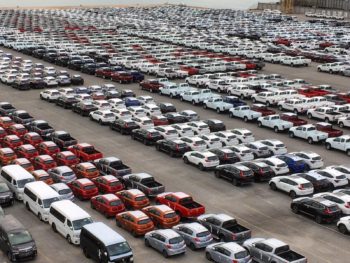The UK’s light commercial vehicle market fell 8.5% in July, while eLCV demand slumped 14.6%.

The newly published figures from the Society of Motor Manufacturers and Traders (SMMT) reveal that 24,689 vans, 4x4s, pickups and taxis joined the road last month – down from the 26,990 units recorded in July last year and marking a second consecutive month of decline.
The SMMT noted that the performance compares with a strong July in 2023 – the best in three years – and follows a record-equalling 17 consecutive months of market growth that only ended in May. As a result, the overall 2024 market remains robust, with registrations up 2.7% year to date, heralding the best first seven months since 2019.
The dip in demand in July affected most segments, with uptake of the largest vans down 12.0% to 16,814 units – still representing more than two-thirds (68.1%) of the overall market. Demand for medium-sized vans dropped 8.4% while deliveries of pickups and 4x4s also fell, by 5.1% and 2.1% respectively.
The smallest vans however saw a spike in demand in July, with registrations more than doubling (117.6%) to 929 units. The new small van market has also been robust across 2024, with demand up 42.0% in the year to date, supported by new model launches.
Demand for battery electric vehicles (BEVs) fell 14.6% to 1,415 units despite a growing number of models available – fleets can now choose from 28 different models, compared to 25 last year.
For the year to date, BEVs accounted for 5.1% of all new vans – including vehicles weighing up to and equal to 3.5 tonnes (4.8%) and those weighing above 3.5 to 4.25 tonnes (0.3%) – down from 5.6% a year ago and far below the 10% target placed on OEMs for 2024 under the ZEV mandate.
The SMMT said mandated targets for van-suitable charging infrastructure are needed fast, and stated that the Plug-in Van Grant must be maintained beyond April 2025 if more businesses are going to decarbonise.
It’s also revised the BEV share of LCV registrations under 3.5t downwards in its latest industry outlook, falling to 6.6%. The general outlook across the new LCV market remains robust however, with 351,000 units expected this year, a 2.8% increase on 2023.
Mike Hawes, SMMT chief executive, said: “Declining uptake of the very greenest models remains a major concern, given the UK’s zero emission ambitions. Industry has invested – and continues to commit – billions into this transition but manufacturers cannot deliver this alone. Given the paucity of van-specific charging infrastructure, we need an equally ambitious mandate for charge point rollout, one that supports operators right across the country.”
The National Franchised Dealers Association (NFDA) has also called for government support.
Sue Robinson, chief executive of the trade body, said: “Fewer large fleets outside the largest cities are transitioning to electric, with new BEV light commercial registrations seeing consecutive declines in uptake.
“This is creating challenges for dealers who are dealing with an oversupply of electric vehicles and a shortage of diesel vehicles. The new electric van market remains well below the 10% target for this year stipulated by the ZEV mandate.
“These figures highlight the crucial need for the Labour government to address industry concerns. These concerns, detailed in NFDA’s General Election manifesto, include removing unfair regulations for heavier, electric vans and increasing HGV MOT capacity by introducing delegated testing.”
Cox Automotive also commented on the latest SMMT figures.
Matthew Davock, director of Manheim Commercial Vehicles, said: “Just as we said about June’s drop, we mustn’t be disheartened with July’s figures. They are as expected and reflect the realities of the current new LCV market. Registrations have tapered off from the highs we were seeing, but these resulted from post-pandemic fleet appetite for new stock and manufacturers’ focus on supplying them. The dynamic has now shifted, and the market is settling.
“The ZEV mandate will influence the rest of this year as the pressure to shift EV volume intensifies. Whether demand aligns with the targets set remains to be seen. The gulf between legislative push and buyer preferences continues to grow, but the deadlines for adoption are getting closer. We urge the new government to listen to the sector, understand the consequences of this conflict, and support the van sector with incentives and infrastructure investment.
“Overall, we remain positive about where we’re at. Activity in the new market has fuelled a strong and vibrant used van market in the first half of 2024. We’ve seen record volumes pass through our Manheim Auction Services and Manheim Vehicle Services locations and wholesale prices reflect the continued demand from used buyers.”

